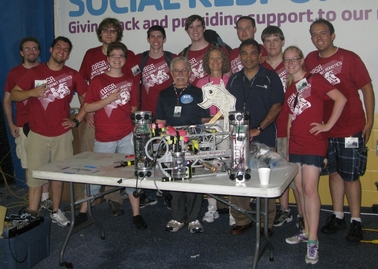Ten team members from Arizona State University’s NASA Space Grant Robotics team flew to Orlando, Florida in June to participate in the Marine Advanced Technology Education (MATE) international robotics competition.
 Team picture with the Koi robot and MATE officials
Team picture with the Koi robot and MATE officials
The ASU team competed against 22 national and international teams by using ‘Koi’, a robot that can work 30-ft underwater. ASU team achieved 11th rank. NASA Space Grant intern, Matthew Plank served as the president of the team.
The ‘MATE competition’ highlights real-world industry problems and ocean-related occupations, with ASU being part of the competition since 2009. Evaluation on the team is done based on their potential to “sell” a design that can fulfill exploratory requirements and real-world crisis.
Previous competitions required the teams to create robots that can investigate underwater volcanoes or to solve the problems underlying the 2010 Gulf Oil Spill. This year’s mission targets a sunken World War II vessel and its possible effect on the environment. By eliminating the fluid from the fuel tank, the robots spanned and mapped the surrounding area. The physical mission provided each team with 15 min to accomplish up to 20 underwater tasks.
The Martin Klein MATE Mariner Award marked the completion of the team’s six month-long effort. A $1,000 grant comes along with this award to support next year’s team. The team bagged a second award. The Engineering Evaluation Most Valuable Player individual award was conferred to Emily McBryan, a senior aerospace engineering major.
In addition to designing and creating award-winning robots, the ASU/NASA Space Grant Robotics team progressed with other efforts too. About 20 active members from varied disciplines were part of the team. Furthermore, the team will take part in the National Underwater Robotics Challenge competition. Also, fully autonomous robots-targeting Association for Unmanned Vehicle Systems International competition will be included in the team’s schedule this year.
Shea Ferring and Robert Wagner serve as mentors for the team. The team will be benefited by NASA Space Grant support, donations and awards. This year’s competition will require the team to create new systems with improved competences.